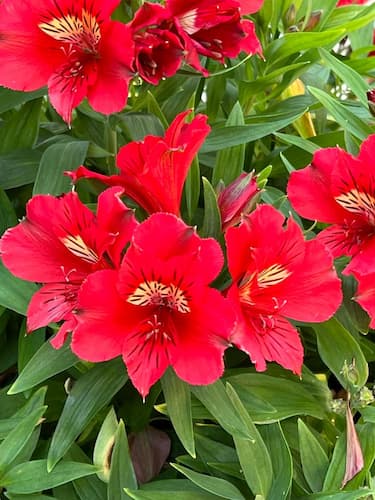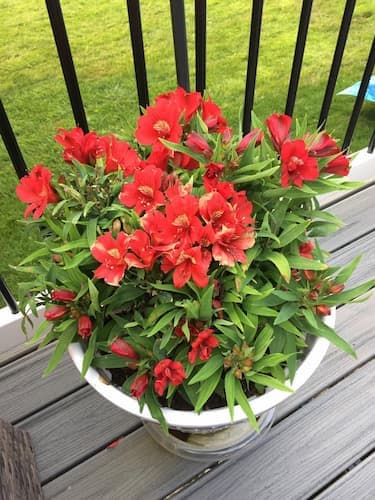How to Grow Colorita Flowers

Growing Colorita Flowers in Your Home Garden or Deck
Looking for a low-maintenance flowering plant that produces vivid, colorful blooms from early spring until frost? Let us introduce you to the perennial Colorita plant! We think you will fall in love with this beautiful plant. Also known as the Peruvian Lily, they are a showpiece plant that is certain to impress visitors or passersby. In addition to its beauty, growing Colorita flowers in your garden or on your deck attract hummingbirds.
The Colorita plant has deciduous and evergreen varieties. It is a perennial plant native to South America. Growing 12 to 15 inches tall, it will look spectacular in your flower garden, or a planter on your patio or deck. The plant has attractive, lush, dark green foliage. The bright, colorful, long-lasting flowers grow atop sturdy stems, making them a popular cut flower. The flowers are azalea-like, and available in a wide range of colors, including orange, pink, red, rose, white, and two-toned. Once they begin to bloom in late spring to early summer, they will continue to produce bright, cheerful blooms all season long.
Garden Tip: Keep soil moist, but not wet or soggy. Wet soils can result in root rot.
Colorita / Peruvian Lily Specifications
Flower Colors: Red is the most popular and attractive. Other colors include orange, pink, purple, white, and yellow.
Flowers Bloom: Mid to late spring that continues throughout the growing season up until the first frost.
Plant Height: 12″ – 15″
Light Requirements: Full sun to partial sun.
Ideal Soil pH: 6.0 – 7.0.
Hardiness Zone: 7 – 10.
Toxicity: This plant is toxic to people and pets.
Native To: South America.
Plant Type: Perennial
Botanical Name: Alstroemeria
Other Names: Peruvian Lily, Lily of the Incas, and Princess Lily
Are Colorita Edible?
NO!!!
The plant is toxic to humans and pert. Keep them away from small children.
Medicinal Uses for Peruvian Lily Plants
Despite being a mildly toxic plant, Peruvian Lilies have a variety of medicinal uses. It has anti-inflammatory and analgesic properties. Among them are:
- Reduces inflammation.
- Pain relief.
- Helps to reduce fever.
- Treats some respiratory ailments.
Light Requirements
Peruvian Lily plants grow best in full sun to partial sun. Six to eight hours o full sunlight is sufficient. In hotter areas of the country, select a growing location where they have light shade during the hottest afternoon sunlight. In these regions, too much hot sun can negatively affect blooming.
Colorita Flower Plant Propagation
Perennial Colorita plants are grown from tuberous rhizomes or seeds. If you prefer to buy plants, they are readily available in most garden stores in the spring.
Gardeners most often propagate new plants from Colorita rhizomes. You can dig up and separate the clumps of rhizomes. Do so carefully. Mound the soil slightly around the planting site to promote good soil drainage. Set the rhizomes on top of the mound and cover them with 2 inches of rich garden soil. Tamp down the soil lightly. Make certain that any stems or shoots protruding from the rhizomes are above the surface of the soil. Water lightly.
Colorita plants can also be grown from seed. The trick is to harvest mature, dry seeds. It is essential that the Colorita seeds are properly dried. This could take several weeks. Store seeds in a cool, dry place until spring. Some growers put the seeds in the freezer for a month or two. Just before planting, rough up the outside seed shell with a fine sandpaper or emery board. Soak seeds overnight.
Also, you can propagate more plants by taking a root cutting.
Every two to three years, dig up the rhizomes. Then, separate them into two or three clumps and replant them. If you have extra, give a clump or two to your garden friends.
More on Propagation Techniques.

How to Grow Perennial Colorita Flower Plants
Colorita are an easy-to-grow, low-maintenance plant.
The plants prefer full to partial sunlight.
The plants grow best in rich soil. Ad a generous amount of compost to the planting site. Good drainage is essential, as the rhizomes can easily rot or get diseases in wet or soggy soils. If grown in planters, use a planter that has a drainage hole in the bottom. Water as needed, to maintain moist to slightly dry soil.
Fertilize monthly.
Mulch around the plant to eliminate weeds and keep the soil moist. As the mulch decomposes, it also feeds the plant.
Container-grown plants – Plants grown in containers have a limited source of nutrients and the soil in planters dries out quickly. Fertilize the plants every 3 to four weeks. Liquid fertilizer works well. Or, use a time-release granular fertilizer. During hot, dry summer weather, you may need to water the plants every day.
Deadhead spent flowers, to promote more blooms.
Pruning Colorita Plants
Remove any dead, or diseased plants and stems.
It doesn’t take long for the plants to fill in a garden space or fill a flowerpot. Thin out tchick, overcrowded grow. This results in healthier plants and bigger blooms. It also helps to minimize plant disease.
It is not necessary to deadhead spent flowers. However, the plants look better if you remove them.
Insects and Plant Disease
Perennial Colorita plants are seldom bothered by insects and disease.
Keep an insecticidal soap handy for the occasional aphid or spider mite infestation.
Rhizome root rot and root fungal diseases are common in wet soils. This includes fungal disease, mosaic virus, and blights. Keeping the soil moist to partly dry helps minimize these problems. Thinning out overcrowded growth also helps to minimize plant disease.
Also see: Plant Problems – Identify the causes and find the cures.
Over-Wintering Plants
No over-wintering is needed in warm weather areas. Your perennial Colorita plants will grow and bloom year-round. In colder areas, these perennial plants die back after the first frost in the fall and can be cut back down to the soil level. In some areas, you can leave the rhizomes in the ground and cover them with a heavy layer of mulch.
The further north you live, the more likely you will need to do more to tuck your plants away for the winter. In cold, northerly climates, there are several ways you can overwinter the plants. For plants in containers move them into a garage. You can also bring container plants indoors for the winter. Caution: check carefully to be sure no insects are looking for a free ride into your warm home. In addition, you can carefully dig up the rhizomes. Next, place the rhizomes in slightly moist soil or peat moss. Then, place them in a completely cool, dark area of your basement. Using this method, you should check the plants for any signs of mold or premature sprouting.
Related Articles
People who read this article will also like:
Plant Problems – causes and cures
Please support our site. Shop for:
- rmmatthews100@hotmail.com
- 585-721-6528
- Rochester, NY
©1999-2024 GardenersNet.Com, All Rights Reserved

